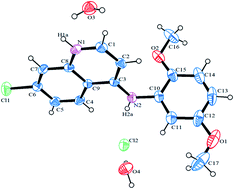The interaction of (7-chloroquinolin-4-yl)-(2,5-dimethoxyphenyl)-amine hydrochloride dihydrate with serum albumin proteins, inputs from spectroscopic, molecular docking and X-ray diffraction studies†
Abstract
The interaction of (7-chloroquinolin-4-yl)-(2,5-dimethoxyphenyl)-amine hydrochloride dihydrate (CQDPA), an amodiaquine analog and a combination partner in antimalarial therapy, with serum albumin proteins (BSA and HSA) was assessed using spectroscopic techniques. Fluorescence studies at three different temperatures confirmed the binding of CQDPA to the active sites of the proteins. The thermodynamic properties such as the enthalpy change (ΔH0), Gibbs free energy change (ΔG0) and entropy change (ΔS0) suggest that the CQDPA molecule binds to site I (subdomain II) of both BSA and HSA through hydrophobic interactions. Based on Förster’s theory of non-radiation energy transfer, the average binding distance r values between the donor (BSA or HSA) and acceptor (CQDPA) were found to be 2.63 and 2.77 for BSA and HSA respectively. A CD study revealed that the α-helical content remained intact in both BSA and HSA on the addition of the amodiaquine analogue but with decreased intensity. The computational analysis and molecular docking of CQDPA with BSA & HSA also corroborated the experimental results.


 Please wait while we load your content...
Please wait while we load your content...